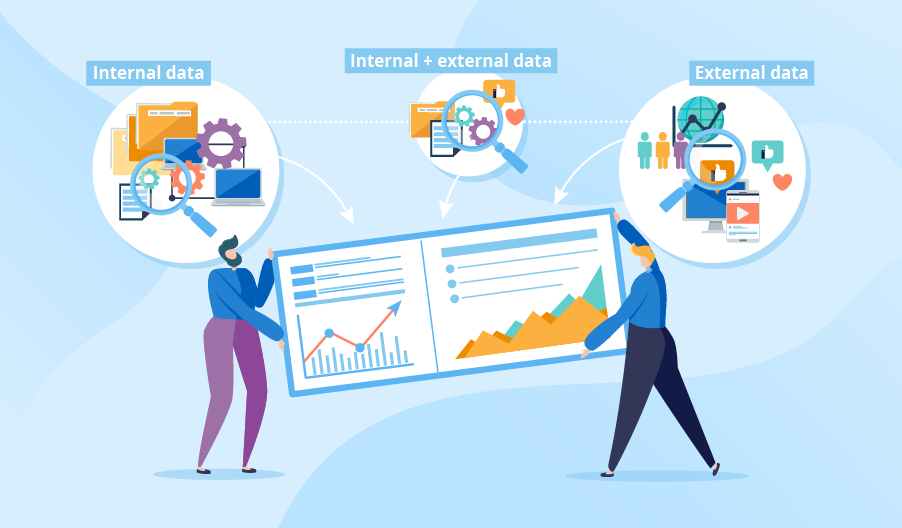Cultural adaptations of the analytics sector have developed in ways and to varying degrees around the world. Analytics is connected with business intelligence — a term that's closely related but carries a slightly different meaning.
In a recent study by Braun Research Incorporated, a new research poll just released, 150 companies revealed that 80% of those companies weren't using their data analytics to their full potential, and 20% were "living in blissful ignorance." Those are pretty high numbers. Of course, data analytics has given rise to big data — and big data can carry big challenges. But don't let these challenges dissuade you from taking advantage of the tips below.
Understand The Business Goals
Knowing what to track is as simple as asking yourself a few key questions. It's important to remember that the business goals are not necessarily the same as marketing goals. If you can align with an executive or someone who knows about the business more than anyone else, this can help you understand a company's KPIs.
Align With a Business Expert
Many companies have a Chief Data Officer (CDO) or Chief Analytics Officer (CAO) in place to help define what key business problems need to be solved. If this is lacking in your organization, then you need someone who can champion your analytics work across different departments.
Define The Key Performance Indicators
You'll need to determine the key performance indicators of your business to make sense of all relevant data. Some examples include customer lifetime value, customer satisfaction rating, customer acquisition cost, and average time spent on the website.
The right KPIs are specific and measurable. They should be directly related to your business goals, and they shouldn’t be too broad or detailed so that you can measure their success with ease.
Map The Customer Journey
The customer experience is a key driver of success, and capturing that journey data can be incredibly valuable to your business. Customers are 50% more likely to do business with companies who personalize communications and offers based on the customer's purchase history. To achieve this level of personalization, you need a deep understanding of each customer's journey.
Know Your Data Sources
The number of available data sets is increasing as more information becomes available online and through third-party providers. Your analytics will only be as good as the quality of your data, so make sure it's coming from a reliable source. External sources could be data from social media, website analytics, surveys, and more.
Ask The Right Questions
Asking the right questions and using them to inform your data collection is crucial for effective data-driven decision-making. You want to be thinking about what kinds of insights you hope to gain from your data. This will help guide you in asking more relevant questions and creating KPIs that fit your goals.
Constantly Check Your Data Quality
One of the most important things you can do to ensure your data analytics are as effective as possible is to make sure that your data is high quality. To check this, ask yourself the following questions:
Are all of the variables in my dataset being collected correctly?
Is my data free of outliers?
Is there any missing data in my dataset?
Does my dataset contain enough examples?
Is my data at the right level of granularity?
Make Sure You Have Access to Data from All Channels
The ability to see a customer's route to buy on a micro level and how each touchpoint influences them is important. It offers improved insights into which messages resonate best with different customers.
Create Relevant Custom Metrics
Custom metrics are great for understanding how users interact with your website. You can start by creating custom metrics that help you learn about user behavior and engagement. For example, if you have an eCommerce site, you might track page views per visit, products added to the cart, and purchases.
Cluster Your Users into Relevant Segments
Segmentation is breaking down a population into groups based on common characteristics such as similarity, interests, or needs. Segmentation allows you to group your users based on attributes relevant to your business. For example, if you run an eCommerce store selling running shoes and casual sneakers, you would ideally segment users who have purchased running shoes from users who've purchased casual sneakers.
Analyze Behavioral Patterns
Knowing how users interact with your product will help you improve its design and guide you in creating marketing strategies. Use a conversion tracking service that allows you to segment visitors based on their behavior. This tool will give you more insight into which groups perform better than others so that you can tailor your marketing efforts.
Use Raw Data When Possible
The more filters, formulas, and transformations you run on your data, the more errors. This factor can skew your results and cause you to make poor business decisions. Use the most raw data possible when doing analytics, which implies no equations or formatting changes. While this isn't always achievable, keep in mind that each data manipulation you perform bears the risk of adding an inaccuracy to your research.
Filter Out Irrelevant Data as Early as Possible
As early as possible, you want to filter out the data that isn't relevant. You should automate the filtering as much as possible. Sometimes it will be faster and easier to do it manually in Excel or Google Sheets. It depends on how much data there is and how complex its structure is.
Integrate Analytics in Your Development Process from Day One
You should think about analytics from the start if you want to ensure that your product or service is continuously improved. Start by using an agile development process, which allows you to gather feedback from real users much sooner in the development cycle. This process will help you shape the product or service and test critical assumptions, making it more likely that you'll get your product to market with a viable tool.
Automate As Much of The Process as You Can
Automate as much of the data collection process as possible. At a minimum, you should automate the collection of all your data sources in one place. Basic data cleaning and analysis should also be automated, such as deleting duplicate rows and identifying unique visitors.
While data analytics is in many ways a creative activity, it also has its own best practices
While data analytics is a creative activity in many aspects, it also has its own best practices. Many individuals have been doing this for years, and those successful at it tend to do things differently. You will achieve better results if you follow these best practices than if you do not.
1https://www.braunresearch.com/component/content/article/27-press-release/93-deflategate





